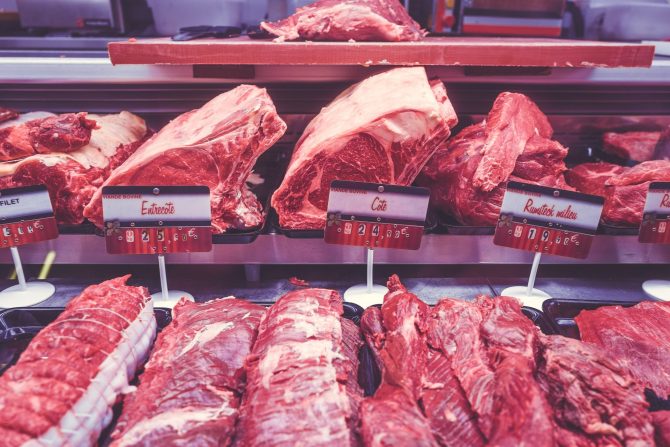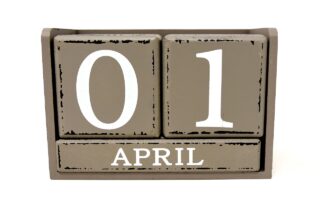French Cuts of Meat: Shopping at the Butchers in France
Essential Reading

If you’re shopping for food in France, whether at the local market, the supermarket meat counter, or visiting the butchers, one thing you might notice is that many of the cuts of meat are different. This isn’t just a question of learning French food vocabulary, it’s also because meat is butchered differently in France.
Some cuts you may be used to simply may not be available in France; others may be slightly different to what you expected. If you’re eating out at a restaurant in France, might also need to reconsider how you order your steak!
To help you out, here’s our quick guide to the main cuts of meat in France, along with some useful direct translations.
Buying Pork: Traditional Cuts in France
The main vocabulary you need when purchasing pork at your French butchers.
- Poitrine – Bacon. A thinly sliced, poitrine, or belly, preserved with salt. The French tend to slice their poitrine fairly thick in order to make lardons, so you need to ask for the slices to be ‘fine’ (pronounced ‘feen’). Bacon is rarely injected with water in France, so you get more for your money, it tastes better and crisps-up easily. Not the same as the packets called ‘bacon’ – these are brined, trimmed pork.
- Echine – meaning shoulder, encompasses the blade bone and spare ribs.
- Plat de côtes – where the hand and belly meet
- Côtes – where the carré comes from, and is made up of loin chops. Basically, rack of pork.
- Filet – in France, is from the hind loin area. The English fillet is from the part which the French call jambon, or ‘ham’.
- If you want your joint with crackling, this should be no problem for your local butcher, but you may need to order it in advance. Ask for the joint ‘avec la couenne’ (pronounced la ‘quwen’).
- joues – cheeks.
Purchasing Chicken, Duck, and Goose in France
Essential vocabulary for the French supermarket or market.
• Poulet – chicken (probably ex-layer, and the ‘normal’ age to buy one).
• Poulette – young chicken.
• Coq – cockerel.
• Pintade – guinea fowl.
• Dinde – turkey.
• Volaille – fowl/ poultry.
• Cuisses – thighs.
• Magret – breast.
• Carcasse – bones for making stocks and soups.
How to Order Lamb from the French Butchers
All the cuts of lamb you can find at your local French butchers.
• Gigot d’agneau – leg of lamb.
• Echine – shoulder.
• Côtes – chump.
• Collet – scrag (end).
• Poitrine/ poitrail – breast
• Côtelette – chop. usually from the rack of lamb, where the British cutlet comes from.
• Jarret – can mean shank or shin.
• Selle d’agneau – saddle.
Different Cuts of Beef and Steak in France
All the ways to purchase beef in France.
• Bifteck/ steak – steak.
• Bavette – undercut – from the skirt, textured with long muscle fibres.
• Filet – fillet.
• Faux-filet – same
• Steak à hacher – used for steak tartare and steak haché. Steak haché looks like a burger, but is simply this high quality steak minced up and pressed together. It is usually freshly done, which is why people are happy to eat them rare. Not comparable to a beef hamburger.
• Romsteak/ rumsteak – rump steak.
• Aloyau – sirloin
• Entrecôte – ribeye.
• Tournedos/ filet mignon – tenderloin steak usually cut almost as high as it is wide. basically a chunk of tender steak, usually served quite rare unless otherwise requested (see ‘Steak Doneness’) You can get ‘tournedos’ of lamb, too.
Additional Beef Produce Available in France
• Tête de veau – head
• Langue de bœuf – beef tongue
• Gîte (à la noix) – topside
• Queue – tail
• Cou – neck
• Tranche – meaning ‘slice’, implies a steak of any meat other than beef.
• Filet/ longue/ aloyau – all words for loin. Loin chop is ‘côte première’.
Buying Meat in France: Understanding Food Labels
If you’re buying pre-packaged meat from the supermarket or trying to understand French food labels, here’s some useful vocabulary to memorise.
Cooking directions
Any meat that says ‘à poêler’ means ‘for frying’;
‘au four’ is for baking/cooking ‘in the oven’
‘á griller’ is grilled
Meat labels and certifications
When purchasing meat you might also see certain logos or labels such as:
‘Bio‘ which means organic or (AB) agriculture biologique, which is the bio label for meat products;
‘élevées en plein air’ is equivalent to the English ‘free range’
You might see mentions of the product origins ‘l’origine du produit’, such as ‘élevées en France’ – raised in France. VPF (viande de porc française) ou VBF (viande bovine française) also guarantee that the pork or beef product comes from France.
Local Life in France
From shopping at the supermarket to sending a parcel at Post Office, finding your local dechetterie to who to call in an emergency—FrenchEntrée is here to help with every aspect of day-to-day living in France. Read our Essential Reading guides for advice on living in France, visit our Shopping zone or Pets zone, or brush up your language skills with our handy learning French resources.
Share to: Facebook Twitter LinkedIn Email



